Beneficial Effect of Polysaccharide Gel Made of Xanthan Gum and Locust Bean Gum on Bovine Oocytes
Abstract
1. Introduction
2. Results
2.1. Gel Culture System Improves Oocyte Developmental Ability
2.2. The Gel Culture System Increased Lipid Content and F-Actine Level and Lowered the Expression Levels of DNA Methylation in 8-Cell Stage Embryos
2.3. RNA-Seq of Oocytes, Cumulus Cells and 8-Cell Stage Embryos
2.4. Effect of the Estradiol and TGFB1 on In Vitro Maturation (IVM) Medium on Oocytes
3. Discussion
4. Materials and Methods
4.1. Ovary Collection
4.2. Chemicals and Media
4.3. Preparation of Gel and IVM
4.4. IVF and IVC of Embryos
4.5. Measurement of Lipid Content in Oocytes
4.6. Evaluation of F-Actin
4.7. Immunostaining
4.8. Measurement of mtDNA Number and ATP Content in Oocytes
4.9. Measurement of Estradiol and TGFB1 Concentration in Spent Culture Medium
4.10. RNA-Seq
4.11. Effect of Supplementation of the IVM Medium with Estradiol on Oocytes
4.12. Statistical Analysis
5. Conclusions
Supplementary Materials
Author Contributions
Funding
Institutional Review Board Statement
Informed Consent Statement
Data Availability Statement
Acknowledgments
Conflicts of Interest
References
- Dieleman, S.J.; Hendriksen, P.J.; Viuff, D.; Thomsen, P.D.; Hyttel, P.; Knijn, H.M.; Wrenzycki, C.; Kruip, T.A.; Niemann, H.; Gadella, B.M.; et al. Effects of in vivo prematuration and in vivo final maturation on developmental capacity and quality of pre-implantation embryos. Theriogenology 2002, 57, 5–20. [Google Scholar] [CrossRef] [PubMed]
- Rizos, D.; Ward, F.; Duffy, P.; Boland, M.P.; Lonergan, P. Consequences of bovine oocyte maturation, fertilization or early embryo development in vitro versus in vivo: Implications for blastocyst yield and blastocyst quality. Mol. Reprod. Dev. 2002, 61, 234–248. [Google Scholar] [CrossRef] [PubMed]
- Egashira, J.; Ihara, Y.; Khatun, H.; Wada, Y.; Konno, T.; Tatemoto, H.; Yamanaka, K.I. Efficient in vitro embryo production using in vivo-matured oocytes from superstimulated Japanese Black cows. J. Reprod. Dev. 2019, 5, 183–190. [Google Scholar] [CrossRef] [PubMed]
- Clarke, H.G.; Hope, S.A.; Byers, S.; Rodgers, R.J. Formation of ovarian follicular fluid may be due to the osmotic potential of large glycosaminoglycans and proteoglycans. Reproduction 2006, 132, 119–131. [Google Scholar] [CrossRef]
- Hara, S.; Aoki, S.; Nagata, M.; Shirasuna, K.; Noguchi, T.; Iwata, H. Xanthan gum and locust bean gum substrate improves bovine embryo development. Reprod. Domest. Anim. = Zuchthygiene 2020, 55, 1124–1131. [Google Scholar] [CrossRef]
- Sugimoto, A.; Inoue, Y.; Tanaka, K.; Sinozawa, A.; Shirasuna, K.; Iwata, H. Effects of a gel culture system made of polysaccharides (xanthan gum and locust bean gum) on in vitro bovine oocyte development and gene expression of the granulosa cells. Mol. Reprod. Dev. 2021, 88, 516–524. [Google Scholar] [CrossRef]
- Aoki, S.; Inoue, Y.; Shinozawa, A.; Tanaka, K.; Shirasuna, K.; Iwata, H. miR-17-5p in bovine oviductal fluid affects embryo development. Mol. Cell. Endocrinol. 2022, 551, 111651. [Google Scholar] [CrossRef]
- Noguchi, T.; Hayashi, T.; Inoue, Y.; Hara, S.; Shirasuna, K.; Iwata, H. Predicting of molecules mediating an interaction between bovine embryos and uterine epithelial cells. J. Reprod. Dev. 2022, 68, 318–323. [Google Scholar] [CrossRef]
- Nagata, S.; Inoue, Y.; Sato, T.; Tanaka, K.; Shinozawa, A.; Shirasuna, K.; Iwata, H. Age-associated changes in miRNA profile of bovine follicular fluid. Reproduction 2022, 164, 195–206. [Google Scholar] [CrossRef]
- Reynier, P.; May-Panloup, P.; Chrétien, M.F.; Morgan, C.J.; Jean, M.; Savagner, F.; Barrière, P.; Malthièry, Y. Mitochondrial DNA content affects the fertilizability of human oocytes. Mol. Hum. Reprod. 2001, 7, 425–429. [Google Scholar] [CrossRef]
- Jeong, W.J.; Cho, S.J.; Lee, H.S.; Deb, G.K.; Lee, Y.S.; Kwon, T.H.; Kong, I.K. Effect of cytoplasmic lipid content on in vitro developmental efficiency of bovine IVP embryos. Theriogenology 2009, 72, 584–589. [Google Scholar] [CrossRef]
- Yang, S.G.; Park, H.J.; Kim, J.W.; Jung, J.M.; Kim, M.J.; Jegal, H.G.; Kim, I.S.; Kang, M.J.; Wee, G.; Yang, H.Y.; et al. Mito-TEMPO improves development competence by reducing superoxide in preimplantation porcine embryos. Sci. Rep. 2018, 8, 10130. [Google Scholar] [CrossRef]
- Dunkley, S.; Scheffler, K.; Mogessie, B. Cytoskeletal form and function in mammalian oocytes and zygotes. Curr. Opin. Cell Biol. 2022, 75, 102073. [Google Scholar] [CrossRef]
- Jiang, Z.; Lin, J.; Dong, H.; Zheng, X.; Marjani, S.L.; Duan, J.; Ouyang, Z.; Chen, J.; Tian, X.C. DNA methylomes of bovine gametes and in vivo produced preimplantation embryos. Biol. Reprod. 2018, 99, 949–959. [Google Scholar] [CrossRef]
- Cheng, H.; Zhang, J.; Zhang, S.; Zhai, Y.; Jiang, Y.; An, X.; Ma, X.; Zhang, X.; Li, Z.; Tang, B. Tet3 is required for normal in vitro fertilization preimplantation embryos development of bovine. Mol. Reprod. Dev. 2019, 86, 298–307. [Google Scholar] [CrossRef]
- Mandal, K.; Raz-Ben Aroush, D.; Graber, Z.T.; Wu, B.; Park, C.Y.; Fredberg, J.J.; Guo, W.; Baumgart, T.; Janmey, P.A. Soft Hyaluronic Gels Promote Cell Spreading, Stress Fibers, Focal Adhesion, and Membrane Tension by Phosphoinositide Signaling, Not Traction Force. ACS Nano 2019, 13, 203–214. [Google Scholar] [CrossRef]
- Humphries, J.D.; Chastney, M.R.; Askari, J.A.; Humphries, M.J. Signal transduction via integrin adhesion complexes. Curr. Opin. Cell Biol. 2019, 56, 14–21. [Google Scholar] [CrossRef]
- Chan, C.J.; Costanzo, M.; Ruiz-Herrero, T.; Mönke, G.; Petrie, R.J.; Bergert, M.; Diz-Muñoz, A.; Mahadevan, L.; Hiiragi, T. Hydraulic control of mammalian embryo size and cell fate. Nature 2019, 571, 112–116. [Google Scholar] [CrossRef]
- Su, Y.Q.; Sugiura, K.; Wigglesworth, K.; O’Brien, M.J.; Affourtit, J.P.; Pangas, S.A.; Matzuk, M.M.; Eppig, J.J. Oocyte regulation of metabolic cooperativity between mouse cumulus cells and oocytes: BMP15 and GDF9 control cholesterol biosynthesis in cumulus cells. Development 2008, 135, 111–121. [Google Scholar] [CrossRef]
- Jackowska, M.; Kempisty, B.; Woźna, M.; Piotrowska, H.; Antosik, P.; Zawierucha, P.; Bukowska, D.; Nowicki, M.; Jaśkowski, J.M.; Brüssow, K.P. Differential expression of GDF9, TGFB1, TGFB2 and TGFB3 in porcine oocytes isolated from follicles of different size before and after culture in vitro. Acta Vet. Hung. 2013, 61, 99–115. [Google Scholar] [CrossRef]
- Hinz, B. The extracellular matrix and transforming growth factor-β1: Tale of a strained relationship. Matrix biology. J. Int. Soc. Matrix Biol. 2015, 47, 54–65. [Google Scholar] [CrossRef] [PubMed]
- Santos, T.A.; El Shourbagy, S.; St John, J.C. Mitochondrial content reflects oocyte variability and fertilization outcome. Fertil. Steril. 2006, 85, 584–591. [Google Scholar] [CrossRef] [PubMed]
- Zeng, H.T.; Ren, Z.; Yeung, W.S.; Shu, Y.M.; Xu, Y.W.; Zhuang, G.L.; Liang, X.Y. Low mitochondrial DNA and ATP contents contribute to the absence of birefringent spindle imaged with PolScope in in vitro matured human oocytes. Hum. Reprod. 2007, 22, 1681–1686. [Google Scholar] [CrossRef] [PubMed]
- Rout, U.K.; Saed, G.M.; Diamond, M.P. Transforming growth factor-β1 modulates expression of adhesion and cytoskeletal proteins in human peritoneal fibroblasts. Fertil. Steril. 2002, 78, 154–161. [Google Scholar] [CrossRef]
- Yi, J.Y.; Hur, K.C.; Lee, E.; Jin, Y.J.; Arteaga, C.L.; Son, Y.S. TGFβ1-mediated epithelial to mesenchymal transition is accompanied by invasion in the SiHa cell line. Eur. J. Cell Biol. 2002, 81, 457–468. [Google Scholar] [CrossRef]
- Wang, D.; Park, J.S.; Chu, J.S.; Krakowski, A.; Luo, K.; Chen, D.J.; Li, S. Proteomic profiling of bone marrow mesenchymal stem cells upon transforming growth factor β1 stimulation. J. Biol. Chem. 2004, 279, 43725–43734. [Google Scholar] [CrossRef]
- Deshmukh, R.S.; Østrup, O.; Østrup, E.; Vejlsted, M.; Niemann, H.; Lucas-Hahn, A.; Petersen, B.; Li, J.; Callesen, H.; Hyttel, P. DNA methylation in porcine preimplantation embryos developed in vivo and produced by in vitro fertilization, parthenogenetic activation and somatic cell nuclear transfer. Epigenetics 2011, 6, 177–187. [Google Scholar] [CrossRef]
- Salilew-Wondim, D.; Saeed-Zidane, M.; Hoelker, M.; Gebremedhn, S.; Poirier, M.; Pandey, H.O.; Tholen, E.; Neuhoff, C.; Held, E.; Besenfelder, U.; et al. Genome-wide DNA methylation patterns of bovine blastocysts derived from in vivo embryos subjected to in vitro culture before, during or after embryonic genome activation. BMC Genom. 2018, 19, 424. [Google Scholar] [CrossRef]
- Graf, A.; Krebs, S.; Zakhartchenko, V.; Schwalb, B.; Blum, H.; Wolf, E. Fine mapping of genome activation in bovine embryos by RNA sequencing. Proc. Natl. Acad. Sci. USA 2014, 111, 4139–4144. [Google Scholar] [CrossRef]
- Aoki, S.; Ito, J.; Hara, S.; Shirasuna, K.; Iwata, H. Effect of maternal aging and vitrification on mitochondrial DNA copy number in embryos and spent culture medium. Reprod. Biol. 2021, 21, 100506. [Google Scholar] [CrossRef]
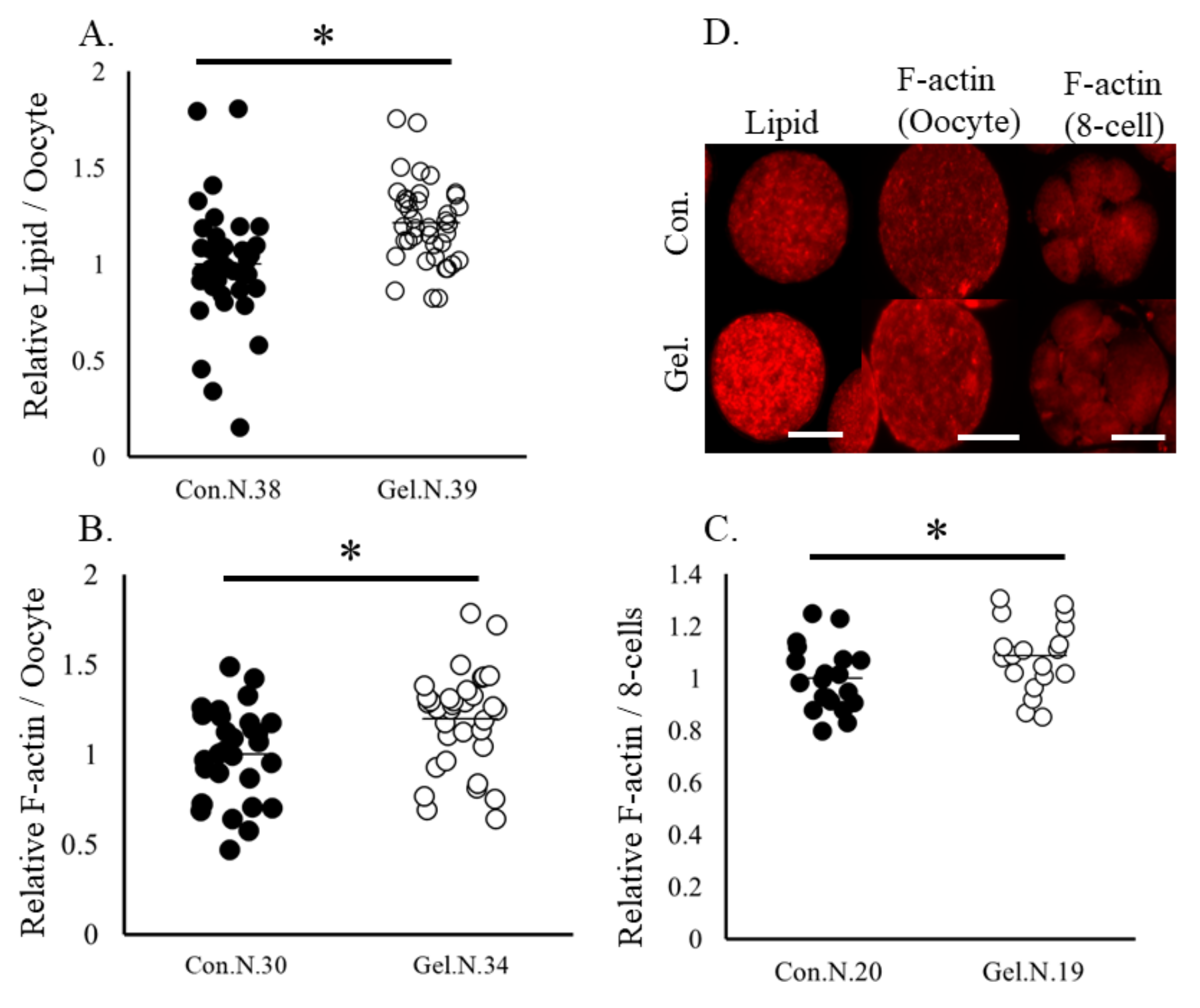

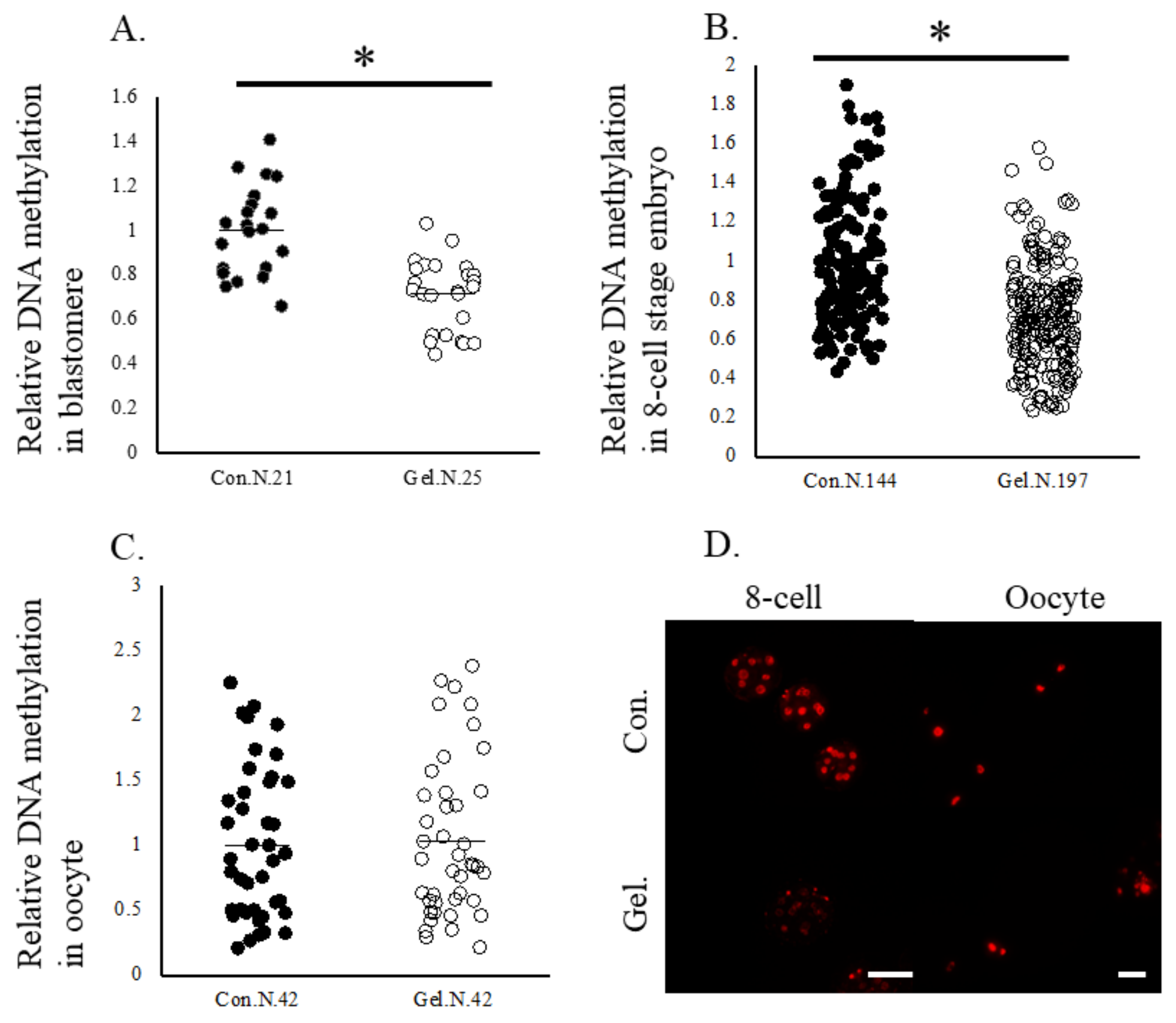
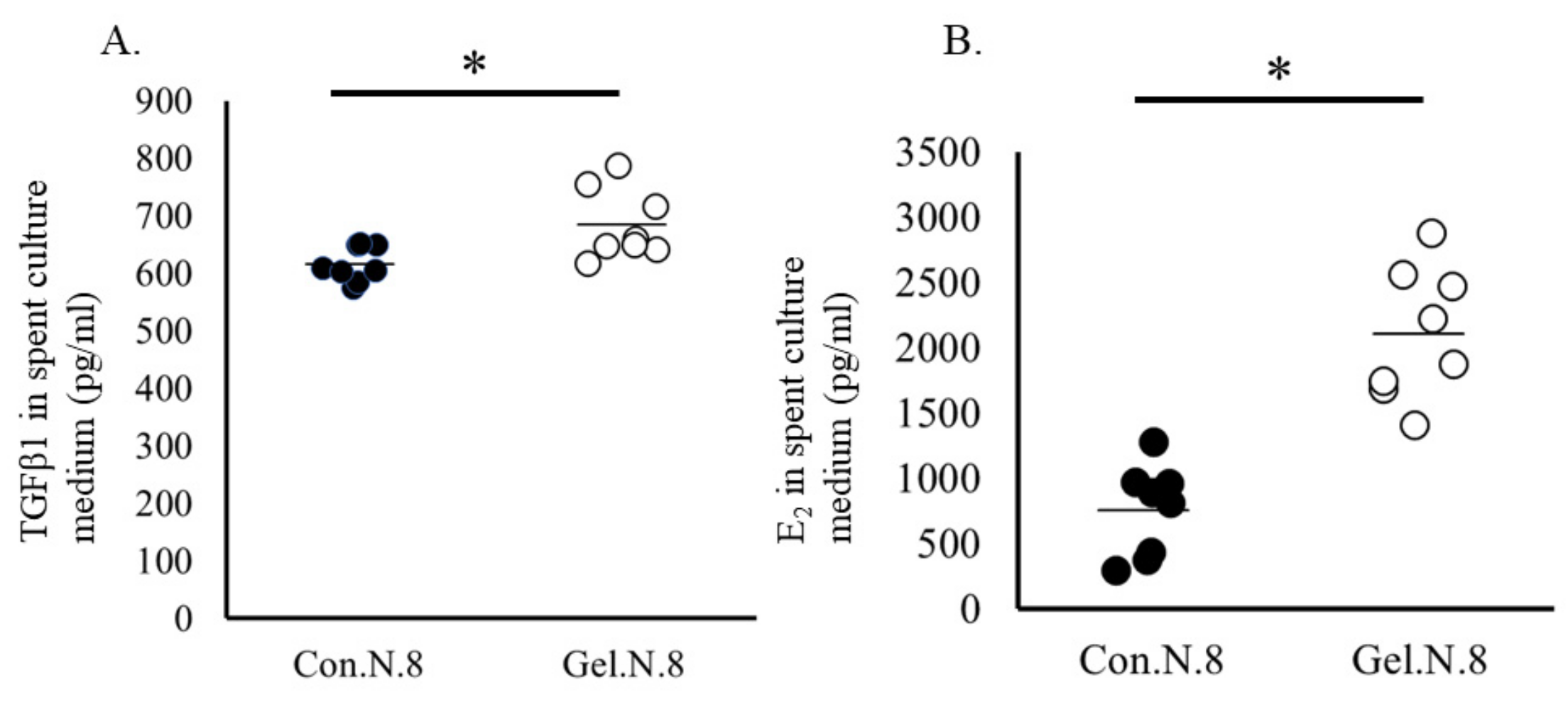
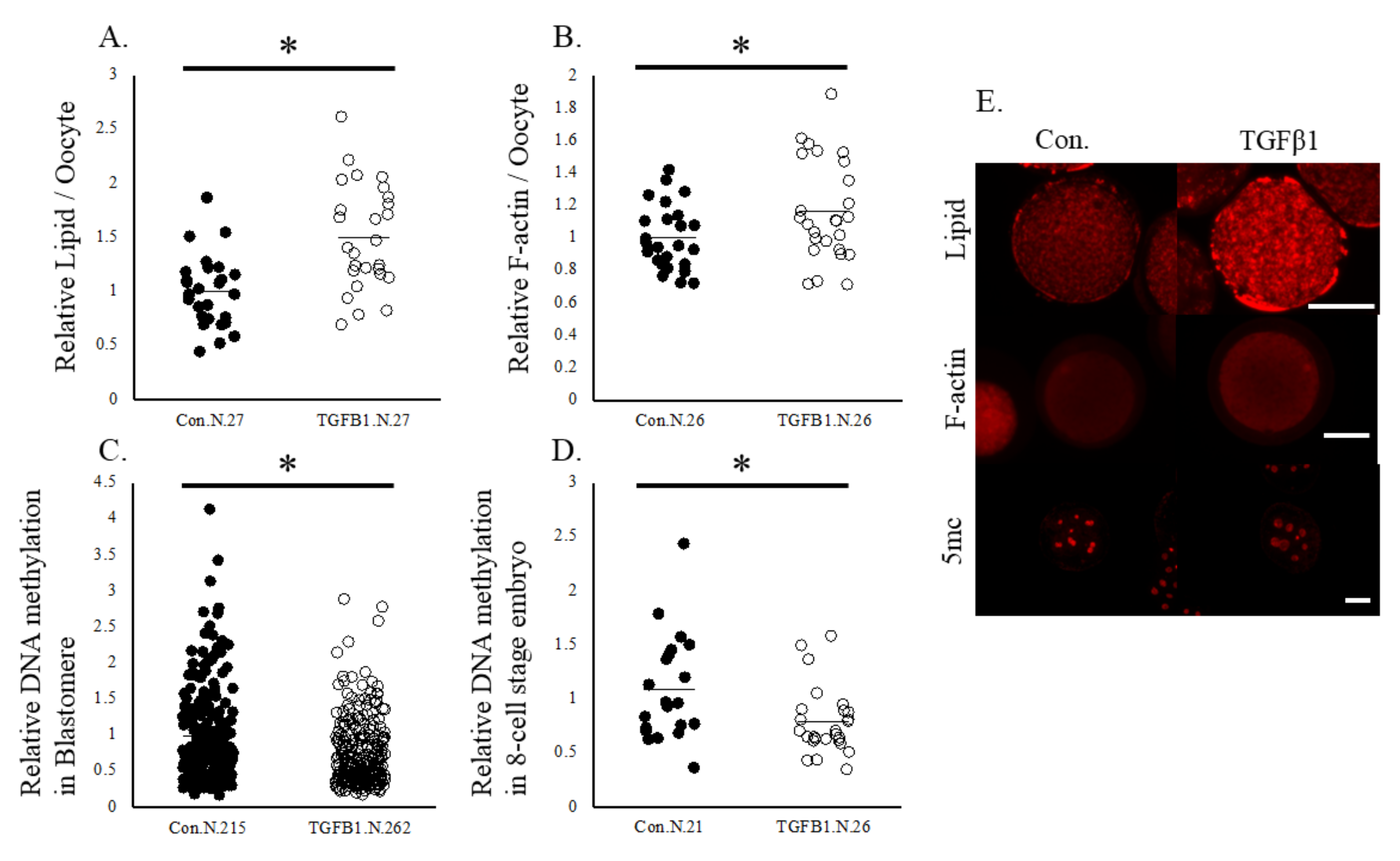

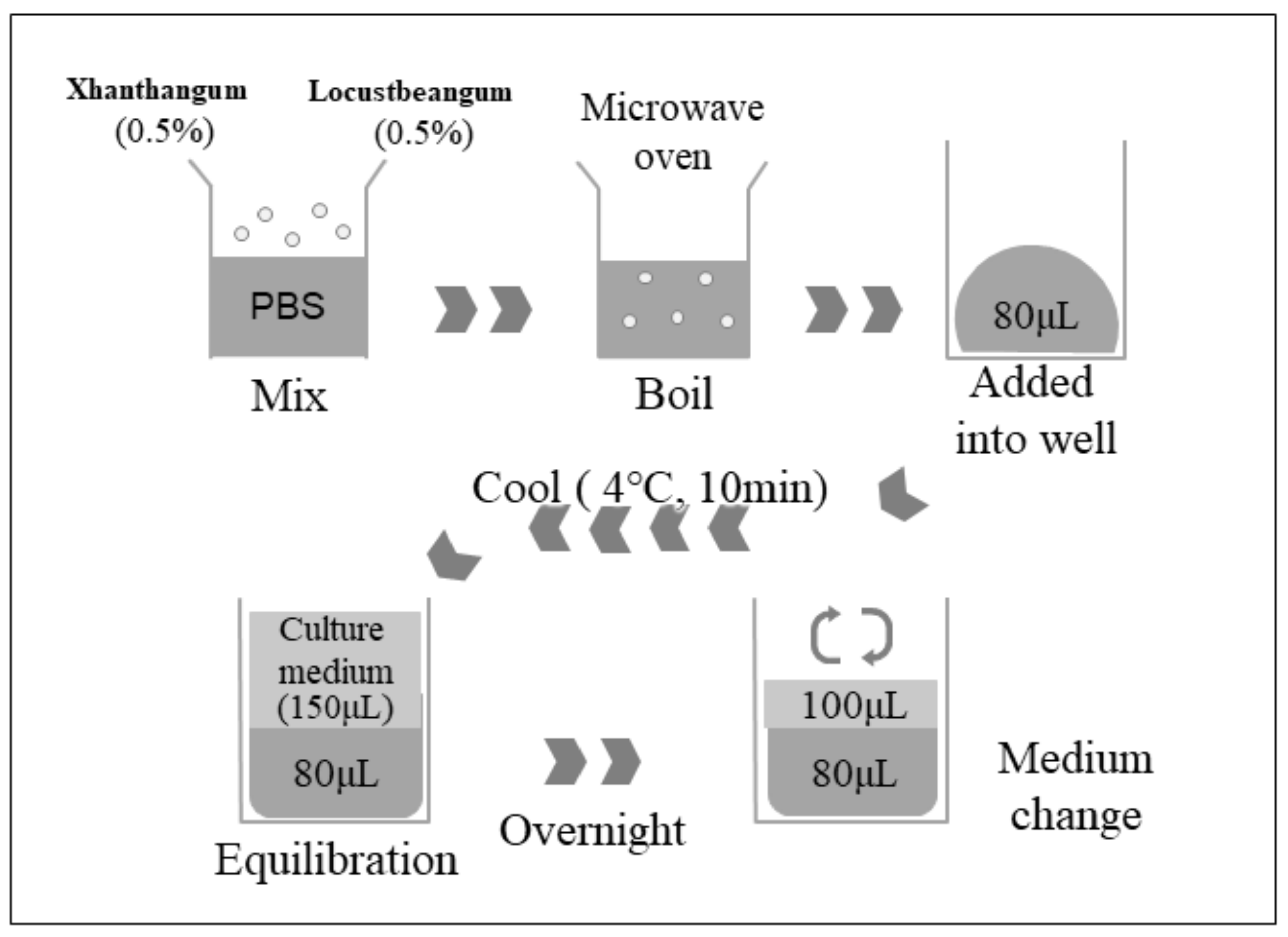
| Group | In Vitro Maturation | In Vitro Fertilization | In Vitro Culture | |||||||||
|---|---|---|---|---|---|---|---|---|---|---|---|---|
| No. of | Rate of | No. of | Rate of | No. of | Rate of | Blastocysts | ||||||
| Trials | Oocytes | M2 (%) | Trials | Oocytes | Normal (%) | Trials | Oocytes | Cleaved | Blastocyst | No. | TCN | |
| Con | 7 | 70 | 72.9 ± 5.2 | 12 | 111 | 87.1 ± 3.0 a | 9 | 90 | 55.6 ± 2.4 | 14.4 ± 2.4 a | 14 | 113.1 ± 7.6 a |
| 1% | 7 | 70 | 82.9 ± 6.1 | 12 | 121 | 93.9 ± 1.7 b | 9 | 100 | 55.6 ± 3.1 | 25.7 ± 4.1 b | 26 | 138.3 ± 8.0 b |
| 2% | 7 | 67 | 65.9 ± 6.1 | 12 | 117 | 86.8 ± 3.1 ab | 9 | 94 | 44.4 ± 2.4 | 14.1 ± 3.4 a | 10 | 81.8 ± 7.2 c |
| Term | Count | p-Value |
|---|---|---|
| Cumulus cells | ||
| ECM-receptor interaction | 24 | 4.49 × 10−9 |
| MAPK signaling pathway | 44 | 1.74 × 10−7 |
| Pathways in cancer | 67 | 1.85 × 10−7 |
| Focal adhesion | 34 | 4.03 × 10−7 |
| Steroid biosynthesis | 10 | 1.45 × 10−6 |
| Arrhythmogenic right ventricular cardiomyopathy | 18 | 4.16 × 10−6 |
| AGE-RAGE signaling pathway in diabetic complications | 20 | 2.25 × 10−5 |
| Rap signaling pathway | 30 | 0.000112 |
| Human papillomavirus infection | 42 | 0.000116 |
| Metabolic pathways | 137 | 0.00015 |
| Oocyte | ||
| Ribosome | 47 | 3.72 × 10−14 |
| Parkinson disease | 57 | 1.79 × 10−10 |
| Huntington disease | 60 | 1.06 × 10−9 |
| Pathways of neurodegeneration—multiple diseases | 80 | 1.38 × 10−9 |
| Coronavirus disease—COVID-19 | 54 | 3.84 × 10−9 |
| Prion disease | 51 | 8.60 × 10−8 |
| Amyotrophic lateral sclerosis | 62 | 1.85 × 10−7 |
| Alzheimer disease | 62 | 1.03 × 10−6 |
| Thermogenesis | 43 | 1.36 × 10−6 |
| Oxidative phosphorylation | 30 | 3.09 × 10−6 |
| Chemical carcinogenesis—reactive oxygen species | 40 | 1.98 × 10−5 |
| Name | Max Group Mean | Fold Change | p-Value |
|---|---|---|---|
| RPKM | Gel/plate | ||
| 8 cell-stage embryo | |||
| DNMT3B | 3.281 | 1.381 | 0.323 |
| DNMT3A | 2.189 | −1.725 | 0.049 |
| DNMT1 | 31.342 | −1.330 | 0.056 |
| TET1 | 0.128 | −1.049 | 0.960 |
| TET2 | 6.817 | −1.271 | 0.180 |
| TET3 | 3.000 | −1.350 | 0.192 |
| Oocytes | |||
| CPT1A | 10.793 | −1.163 | 0.039 |
| FADS2 | 0.316 | 2.800 | 0.010 |
| GDF9 | 399.813 | 1.212 | 0.006 |
| ITGAV | 5.460 | 1.967 | 0.002 |
| ITGB3 | 1.921 | 1.666 | 0.001 |
| MECR | 0.852 | −1.617 | 0.027 |
| SCD | 9.917 | 2.379 | 0.004 |
| TGFBI | 2.130 | −1.095 | 0.874 |
| Cumulus cells | |||
| CYP19A1 | 0.913 | 2.150 | 0.002 |
| ITGB3 | 125.190 | 1.290 | 0.002 |
| ITGAV | 272.418 | 1.220 | 0.028 |
| TGFB1 | 22.786 | 1.040 | 0.675 |
| Upstream | Molecular | Predicted | Activation | p Value |
|---|---|---|---|---|
| Regulator | Type | Activation State | Z-Score | of Overlap |
| beta-estradiol | chemical-endogenous mammalian | Activated | 5.826 | 3.17 × 10−50 |
| TGFB1 | growth factor | Activated | 7.165 | 2.93 × 10−47 |
| dexamethasone | chemical drug | Activated | 4.082 | 1.61 × 10−42 |
| TNF | cytokine | Activated | 4.627 | 4.53 × 10−42 |
| AGT | growth factor | Activated | 6.23 | 2.05 × 10−34 |
| CG | complex | Activated | 4.499 | 1.91 × 10−33 |
| PD98059 | Chemical: kinase inhibitor | Inhibited | −5.238 | 9.41 × 10−32 |
| lipopolysaccharide | chemical drug | Activated | 6.403 | 2.66 × 10−31 |
| IFNG | cytokine | Activated | 5.852 | 1.02 × 10−30 |
| tretinoin | Chemical: endogenous mammalian | Activated | 3.597 | 3.6 × 10−28 |
| IL1B | cytokine | Activated | 5.168 | 6.91 × 10−28 |
| LY294002 | Chemical: kinase inhibitor | Inhibited | −5.177 | 2.22 × 10−27 |
| progesterone | Chemical: endogenous mammalian | Activated | 2.93 | 4.47 × 10−27 |
| ESR2 | ligand-dependent nuclear receptor | 1.965 | 5.74 × 10−27 | |
| U0126 | Chemical: kinase inhibitor | Inhibited | −4.479 | 3.32 × 10−25 |
| STAT3 | transcription regulator | Activated | 2.553 | 6.35 × 10−25 |
| PDGF BB | complex | Activated | 4.112 | 1.66 × 10−24 |
| MAP2K5 | kinase | Activated | 4.991 | 2.57 × 10−24 |
| TGFB | group | Activated | 3.897 | 3.03 × 10−24 |
| TP53 | transcription regulator | 1.597 | 3.79 × 10−24 |
| Upstream | Molecular | Predicted | Activation | p Value |
|---|---|---|---|---|
| Regulator | Type | Activation State | Z-Score | of Overlap |
| MYC | transcription regulator | Activated | 7.392 | 3.42 × 10−21 |
| MYCN | transcription regulator | Activated | 3 | 9.15 × 10−21 |
| beta-estradiol | chemical-endogenous mammalian | Activated | 3.75 | 1.14 × 10−20 |
| torin1 | chemical reagent | Inhibited | −4.543 | 1.32 × 10−19 |
| Lh | complex | Activated | 4.001 | 3.15 × 10−19 |
| TP53 | transcription regulator | 1.571 | 3.73 × 10−19 | |
| LARP1 | translation regulator | Inhibited | −5.743 | 2.63 × 10−18 |
| APP | other | 0.412 | 3.84 × 10−16 | |
| CTNNB1 | transcription regulator | 1.635 | 1.24 × 10−15 | |
| TGFB1 | growth factor | Activated | 2.748 | 1.61 × 10−14 |
| MAPT | other | 0 | 1.98 × 10−14 | |
| RICTOR | other | Inhibited | −6.308 | 5.72 × 10−14 |
| ESR1 | ligand-dependent nuclear receptor | Activated | 3.228 | 5.94 × 10−13 |
| ST1926 | chemical drug | Inhibited | −5.492 | 1.22 × 10−12 |
| tretinoin | chemical-endogenous mammalian | −0.169 | 2 × 10−12 | |
| acyline | biologic drug | 4.67 × 10−12 | ||
| ESR2 | ligand-dependent nuclear receptor | Activated | 2.958 | 5.68 × 10−12 |
| MLXIPL | transcription regulator | Activated | 5.444 | 5.69 × 10−12 |
| dihydrotestosterone | chemical-endogenous mammalian | Activated | 2.984 | 3.36 × 10−11 |
| decitabine | chemical drug | 1.223 | 4.75 × 10−11 |
| Term | Count | p-Value |
|---|---|---|
| Nicotine addiction | 7 | 0.0028997 |
| Neuroactive ligand-receptor interaction | 26 | 0.0037227 |
| Cell adhesion molecules | 14 | 0.0090386 |
| Human papillomavirus infection | 22 | 0.0166348 |
| GABAergic synapse | 9 | 0.0168932 |
| Cytokine-cytokine receptor interaction | 21 | 0.0179321 |
| PI3K-Akt signaling pathway | 23 | 0.0190965 |
| PD-L1 expression and PD-1 checkpoint pathway in cancer | 9 | 0.0201767 |
| Type I diabetes mellitus | 7 | 0.0207458 |
| Taste transduction | 8 | 0.0301596 |
| Herpes simplex virus 1 infection | 23 | 0.04698 |
| Group | No. of | No. of | Rate of |
|---|---|---|---|
| Trials | Oocytes | Blast. | |
| Con. | 9 | 89 | 20.1 ± 2.2 a |
| TGFB1 | 9 | 89 | 30.2 ± 1.4 b |
| Con | 9 | 90 | 28.9 ± 3.3 |
| Estradiol | 9 | 90 | 23.3 ± 3.1 |
Disclaimer/Publisher’s Note: The statements, opinions and data contained in all publications are solely those of the individual author(s) and contributor(s) and not of MDPI and/or the editor(s). MDPI and/or the editor(s) disclaim responsibility for any injury to people or property resulting from any ideas, methods, instructions or products referred to in the content. |
© 2023 by the authors. Licensee MDPI, Basel, Switzerland. This article is an open access article distributed under the terms and conditions of the Creative Commons Attribution (CC BY) license (https://creativecommons.org/licenses/by/4.0/).
Share and Cite
Hara, S.; Inoue, Y.; Aoki, S.; Tanaka, K.; Shirasuna, K.; Iwata, H. Beneficial Effect of Polysaccharide Gel Made of Xanthan Gum and Locust Bean Gum on Bovine Oocytes. Int. J. Mol. Sci. 2023, 24, 3508. https://doi.org/10.3390/ijms24043508
Hara S, Inoue Y, Aoki S, Tanaka K, Shirasuna K, Iwata H. Beneficial Effect of Polysaccharide Gel Made of Xanthan Gum and Locust Bean Gum on Bovine Oocytes. International Journal of Molecular Sciences. 2023; 24(4):3508. https://doi.org/10.3390/ijms24043508
Chicago/Turabian StyleHara, Shunsuke, Yuki Inoue, Sogo Aoki, Keisuke Tanaka, Koumei Shirasuna, and Hisataka Iwata. 2023. "Beneficial Effect of Polysaccharide Gel Made of Xanthan Gum and Locust Bean Gum on Bovine Oocytes" International Journal of Molecular Sciences 24, no. 4: 3508. https://doi.org/10.3390/ijms24043508
APA StyleHara, S., Inoue, Y., Aoki, S., Tanaka, K., Shirasuna, K., & Iwata, H. (2023). Beneficial Effect of Polysaccharide Gel Made of Xanthan Gum and Locust Bean Gum on Bovine Oocytes. International Journal of Molecular Sciences, 24(4), 3508. https://doi.org/10.3390/ijms24043508







